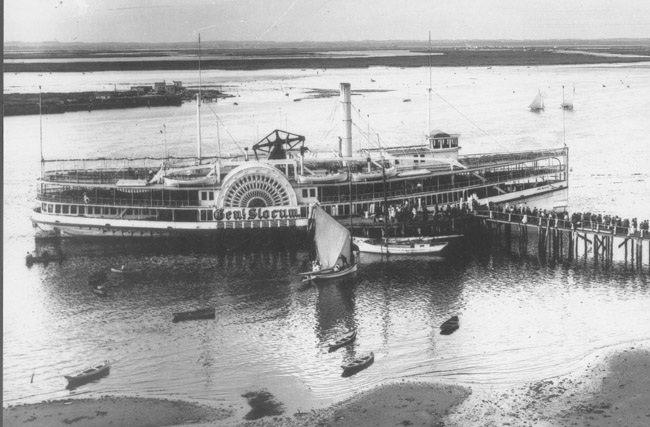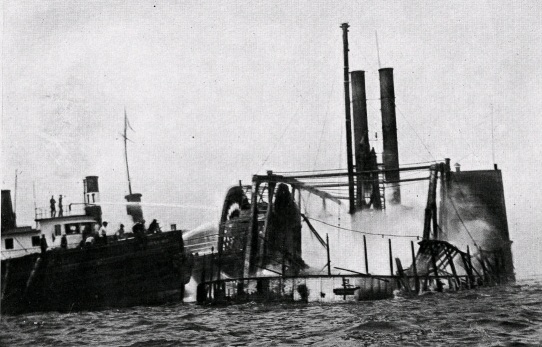The General Slocum was an excursion steamer named after a Civil War General, and New York Congressman, Henry Warner Slocum. She was launched on April 18, 1891, and on June 25, 1891, steamed her maiden voyage. The General Slocum was classified as a Sidewheeler, and was 235 ft long. She required a crew of 22, and had a maximum speed of 16 nots.
The General Slocum did not have a peaceful life. Before the end of 1891, she ran aground off Rockaway, requiring tugboats to free her. In July of 1894, she struck a sandbar with sufficient force to deactivate the electrical generator. In August of 1894, a storm ran her aground off Coney Island, requiring passengers to be evacuated by another ship. The next month, September 1894, she collided with a Tugboat, substantially damaging her steering. In July 1894, she suffered a collision with yet another vessel off Battery Park.
In August of 1901, a riot began on-board when some of the 900 Paterson Anarchists on board, highly intoxicated, attempted to take control of the vessel. Upon docking at the police pier, 17 men were arrested. A year later, in June 1902, she again ran aground, this time passengers remained on the ship, effectively camping over night.
On Wednesday, June 15, 1904, St. Mark's Evangelical Lutheran Church, chartered the General Slocum for $350, as they had for 17 years. The trip was to take 1400 passengers up the East River, and into Long Island Sound, where it would bring them to Locust Grove, a picnic site in Eatons Neck, Long Island.
The church was based in the "Little Germany" section of Manhattan, on the Lower East Side. This neighborhood was predominantly composed of German immigrants starting in the 1840s. As the 19th century progressed, the German Population was shrinking as non-German Immigrants started settling in the area, and the second-generation German-American families started moving to other communities such as Williamsburg, Brooklyn, and Yorkville, on the Upper East side.
On the fateful day, the General Slocum, got underway at 9:30 AM. By the time she was even with East 90th Street, a fire had started in the Lamp Room, which was full of straw, oily rags, and lamp oil. There is speculation as to the cause, such as a discarded cigarette or match. For half an hour, the fire was not reported. At 10:00 AM notice of the fire was given.
The General Slocum's safety equipment had not fared much better than the rest of the ship in the ensuing years. The crew attempted to put the fire out with the fire hoses on the ship. As they did so, the hoses, which had been allowed to rot, fell apart. The lifeboats were tied up, and possibly even wired and painted in place, and not accessible.
Perhaps most egregious was the condition of the life-preservers and life-jackets. The life preservers crumbled as people attempted to use them. The ones that didn't crumble sunk, as iron bars may have been placed inside of them to bring them up to the the weight required. Other preservers were made of granulated cork which was supplimented with iron weights. The Life-jackets were not much better. Mothers, desperate to save their children, put the jackets on their children, only to experience the horror of watching the children sink.
Those who did not rely on these life preservers and life jackets did not fare much better. In 1901, few people could swim, especially not women and children who constituted the majority of the passengers. In addition, the heavy wool clothing they were wearing would make swimming impossible.
The crew was not much help. No fire drills had ever been held. In addition, Captain Van Schaick continued his course, rather than stop the ship at the nearest landing, or running the ship ashore. The course brought the ship into headwinds, which in effect fanned the fire.
The General Slocum finally sank at North Brother Island, Between the Bronx, and Rikers Island.
The toll was horrible. There were 321 survivors, and 1,021 people died by drowning or fire. Of the 30 crew members on board, 2 died. The captain went blind in one eye due to the fire, though he managed to desert the ship with several crew members as soon as it settled.
There were eight people indicted in Federal court: the Captain and two inspecters, along with the president, secretary, treasurer, and commodore of the Knickerbocker Steamship Company. The only conviction was Captain Van Schaick, for criminal negligence. The jury did not reach a verdict on two counts of manslaughter. Van Shaick was sentenced to 10 years imprisionment, serving three and a half years at Sing Sing before being paroled, and then eventually pardoned by President Taft. President Theodore Roosevelt opted not to pardon the captain.
The disaster caused Little Germany to virtually disappear, with the remaining Germans mostly moving uptown. St. Mark's Lutheran Church is now a synagogue.
The last surviving passenger, Adella Wortherspoon (nee Liebenow) died on January 26, 2004 at 100 years old. She was six-months old at the time of the incident, and the youngest survivor.





 RSS Feed
RSS Feed